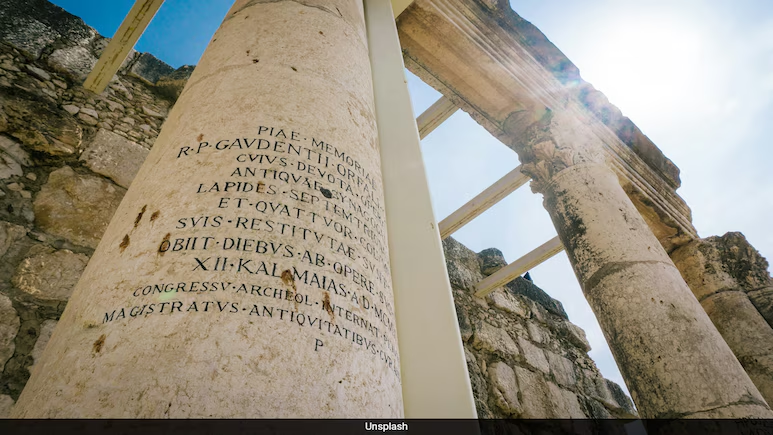New AI Tool Aeneas Brings Ancient Roman History to Life
In an impressive stride towards bridging technology and history, Google DeepMind has unveiled a powerful new artificial intelligence tool named Aeneas, designed specifically to assist historians in decoding the complexities of ancient Roman inscriptions. This groundbreaking tool, developed in collaboration with prominent historians including Dr. Thea Sommerschield from the University of Nottingham, aims to revolutionize how we understand and interpret historical texts. Aeneas analyzes inscriptions found on monuments, tombs, and everyday items, many of which are fragmented or worn, making their interpretation a daunting task.
Aeneas utilizes a rich database consisting of nearly 200,000 Latin inscriptions, comprising a staggering total of over 16 million characters. By doing so, it provides insights into the origin and date of these inscriptions while also suggesting missing words in damaged texts. This tool not only leverages keyword matching but employs deeper linguistic and historical analysis, enabling scholars to make connections that would have previously required extensive manual research.
As per the report by The Guardian, Aeneas is named after the legendary Trojan hero from Roman mythology, a fitting tribute considering its significant role in unraveling the narratives of ancient Rome. By employing advanced AI technology, Aeneas empowers historians, researchers, and enthusiasts alike to engage with history in ways that were previously unimaginable.
How Aeneas Works: Methodology and Benefits
Aeneas’s operation involves a sophisticated analysis of both the textual content and images of the inscriptions. It evaluates similarities between various inscriptions from the 7th century BC to the 8th century AD, determining the likely Roman province where the inscription was created and estimating its date to within approximately 13 years. This level of accuracy is unprecedented in the field of historical linguistics and archaeology.
Furthermore, Aeneas’s capability to propose possible words to fill in missing parts of texts is yet another feature that sets it apart from traditional methods. The tool has demonstrated its efficacy in tests involving well-known inscriptions like the Res Gestae Divi Augusti, shedding light on texts that were previously difficult to interpret due to damage or erosion. This capability is a game-changer for historians looking to connect similar texts from different regions of the Roman Empire, thus enriching our understanding of Roman culture and society.
In a study involving 23 researchers, it was found that Aeneas was deemed “transformative” and proved useful in 90% of cases. Historians are now expressing excitement over the enhanced opportunities this tool presents for the field of Roman studies. With the ability to analyze inscriptions rapidly and accurately, Aeneas is set to democratize access to historical research, allowing more individuals to contribute to the exploration of ancient texts without needing rare materials or extensive background knowledge.
The Implications for Historical Research
The implications of Aeneas for historical research are significant. Scholars believe that this AI tool might herald a new era in the study of Latin inscriptions, creating pathways for collaborative research that includes historians and enthusiasts alike. The ease of use provided by Aeneas is expected to increase public interest in ancient Roman culture, encouraging a broader audience to engage with historical texts and contribute to ongoing research efforts.
Moreover, Aeneas’s design necessitates a thoughtful and critical approach to the interpretations it provides. While the tool offers great potential, historians urge caution in its application, emphasizing the importance of verifying AI-generated insights with traditional scholarly methods. It is crucial for researchers to remain vigilant against over-reliance on technology, which could lead to oversights or inaccuracies in understanding the nuances of ancient languages and cultures.
Embracing the Future of Historical Studies
As Aeneas becomes widely adopted, the academic community is preparing for a transformative shift in the methodologies used in historical studies. The automation of traditional research methods can lead to vast improvements in efficiency, allowing historians to focus more on interpretation and less on labor-intensive tasks. Furthermore, as more users engage with Aeneas, the tool’s algorithm can evolve, potentially enhancing its accuracy and capabilities over time.
In an era where technology continually reshapes our methods of communication, research, and learning, AI tools like Aeneas represent a significant advancement in the humanities. The confluence of history and artificial intelligence is not merely a passing trend; it reflects a profound shift in how we can visualize, analyze, and understand our past.
If you’re interested in learning more about the historical significance of Latin inscriptions, check out our related articles on The Historical Context of Roman Inscriptions and The Role of AI in Advancing the Humanities.
With Aeneas, Google not only enhances the tools available to historians but also ignites a renewed passion for the exploration of ancient civilizations. As Aeneas embarks on its journey in the world of historical inquiry, it stands ready to inspire a new generation of scholars eager to uncover the mysteries of the past.
DISCLAIMER
We have taken every measure to ensure that the information in this article and on our social media platforms is accurate, verified, and obtained from reliable sources. For feedback or complaints, please contact us at info@hamslive.com.


